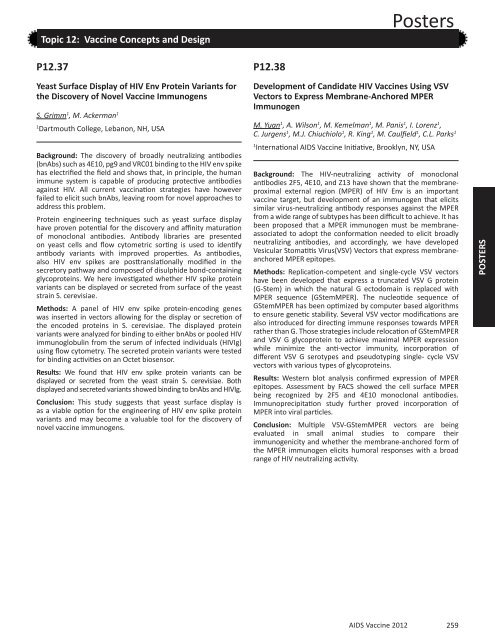Oral Abstract Session 01 - Global HIV Vaccine Enterprise
Oral Abstract Session 01 - Global HIV Vaccine Enterprise
Oral Abstract Session 01 - Global HIV Vaccine Enterprise
You also want an ePaper? Increase the reach of your titles
YUMPU automatically turns print PDFs into web optimized ePapers that Google loves.
Topic 12: <strong>Vaccine</strong> Concepts and Design<br />
P12.37<br />
Yeast Surface Display of <strong>HIV</strong> Env Protein Variants for<br />
the Discovery of Novel <strong>Vaccine</strong> Immunogens<br />
S. Grimm 1 , M. Ackerman 1<br />
1 Dartmouth College, Lebanon, NH, USA<br />
Background: The discovery of broadly neutralizing antibodies<br />
(bnAbs) such as 4E10, pg9 and VRC<strong>01</strong> binding to the <strong>HIV</strong> env spike<br />
has electrified the field and shows that, in principle, the human<br />
immune system is capable of producing protective antibodies<br />
against <strong>HIV</strong>. All current vaccination strategies have however<br />
failed to elicit such bnAbs, leaving room for novel approaches to<br />
address this problem.<br />
Protein engineering techniques such as yeast surface display<br />
have proven potential for the discovery and affinity maturation<br />
of monoclonal antibodies. Antibody libraries are presented<br />
on yeast cells and flow cytometric sorting is used to identify<br />
antibody variants with improved properties. As antibodies,<br />
also <strong>HIV</strong> env spikes are posttranslationally modified in the<br />
secretory pathway and composed of disulphide bond-containing<br />
glycoproteins. We here investigated whether <strong>HIV</strong> spike protein<br />
variants can be displayed or secreted from surface of the yeast<br />
strain S. cerevisiae.<br />
Methods: A panel of <strong>HIV</strong> env spike protein-encoding genes<br />
was inserted in vectors allowing for the display or secretion of<br />
the encoded proteins in S. cerevisiae. The displayed protein<br />
variants were analyzed for binding to either bnAbs or pooled <strong>HIV</strong><br />
immunoglobulin from the serum of infected individuals (<strong>HIV</strong>Ig)<br />
using flow cytometry. The secreted protein variants were tested<br />
for binding activities on an Octet biosensor.<br />
Results: We found that <strong>HIV</strong> env spike protein variants can be<br />
displayed or secreted from the yeast strain S. cerevisiae. Both<br />
displayed and secreted variants showed binding to bnAbs and <strong>HIV</strong>Ig.<br />
Conclusion: This study suggests that yeast surface display is<br />
as a viable option for the engineering of <strong>HIV</strong> env spike protein<br />
variants and may become a valuable tool for the discovery of<br />
novel vaccine immunogens.<br />
P12.38<br />
AIDS <strong>Vaccine</strong> 2<strong>01</strong>2<br />
Posters<br />
Development of Candidate <strong>HIV</strong> <strong>Vaccine</strong>s Using VSV<br />
Vectors to Express Membrane-Anchored MPER<br />
Immunogen<br />
M. Yuan 1 , A. Wilson 1 , M. Kemelman 1 , M. Panis 1 , I. Lorenz 1 ,<br />
C. Jurgens 1 , M.J. Chiuchiolo 1 , R. King 1 , M. Caulfield 1 , C.L. Parks 1<br />
1 International AIDS <strong>Vaccine</strong> Initiative, Brooklyn, NY, USA<br />
Background: The <strong>HIV</strong>-neutralizing activity of monoclonal<br />
antibodies 2F5, 4E10, and Z13 have shown that the membraneproximal<br />
external region (MPER) of <strong>HIV</strong> Env is an important<br />
vaccine target, but development of an immunogen that elicits<br />
similar virus-neutralizing antibody responses against the MPER<br />
from a wide range of subtypes has been difficult to achieve. It has<br />
been proposed that a MPER immunogen must be membraneassociated<br />
to adopt the conformation needed to elicit broadly<br />
neutralizing antibodies, and accordingly, we have developed<br />
Vesicular Stomatitis Virus(VSV) Vectors that express membraneanchored<br />
MPER epitopes.<br />
Methods: Replication-competent and single-cycle VSV vectors<br />
have been developed that express a truncated VSV G protein<br />
(G-Stem) in which the natural G ectodomain is replaced with<br />
MPER sequence (GStemMPER). The nucleotide sequence of<br />
GStemMPER has been optimized by computer based algorithms<br />
to ensure genetic stability. Several VSV vector modifications are<br />
also introduced for directing immune responses towards MPER<br />
rather than G. Those strategies include relocation of GStemMPER<br />
and VSV G glycoprotein to achieve maximal MPER expression<br />
while minimize the anti-vector immunity, incorporation of<br />
different VSV G serotypes and pseudotyping single- cycle VSV<br />
vectors with various types of glycoproteins.<br />
Results: Western blot analysis confirmed expression of MPER<br />
epitopes. Assessment by FACS showed the cell surface MPER<br />
being recognized by 2F5 and 4E10 monoclonal antibodies.<br />
Immunoprecipitation study further proved incorporation of<br />
MPER into viral particles.<br />
Conclusion: Multiple VSV-GStemMPER vectors are being<br />
evaluated in small animal studies to compare their<br />
immunogenicity and whether the membrane-anchored form of<br />
the MPER immunogen elicits humoral responses with a broad<br />
range of <strong>HIV</strong> neutralizing activity.<br />
259<br />
POSTERS


